Todd Montanaro, landscape painter and art dealer
Finding his voice as a painter, how he accidentally ended up selling famous paintings, and the joy of being part of a rich artist community tradition.
Embedded with ice cream shops and lobster shacks on Rockport’s Bearskin Neck is a gem of an art gallery and studio: Gallery Montanaro. Visit and soak up a lesson in the historic Cape Ann School of Painting by looking at paintings by Aldro Hibbard, Emile Gruppe, Charles Movalli, among many others, along with the contemporary work of New England artists, including owner Todd Montanaro. When you visit the gallery, you’ll likely see one of Montanaro’s paintings in progress.
When he’s not at the gallery, he’s often outside, sometimes accompanied by other painters, capturing on canvas when the light and shadows are their most beautiful. As a dedicated plein air painter, he ventures forth on breezy summer mornings and icy winter days when the snow reflects light and does magical things to the colors around it.
Todd Montanaro is passionate about painting and equally so about collecting art he loves. But unlike some collectors, he embraces the idea of art stewardship—that is, acquiring paintings that excite him and then enjoying them briefly before helping them find a new home.
Here, Montanaro talks about the difference between gaining proficiency as an artist and what it means for one’s art to express a point of view.
Your path to being an artist and art dealer doesn’t seem so straightforward. Can you describe how you got here?
I was always drawing as a child and I won awards for my art in high school. I went to college with the intention of studying art but switched to business because I was persuaded by my parents to have a career that wouldn’t leave me hungry [laughs]. This happens to a lot of people. I took a number of studio classes in college and worked primarily in business for 10 years until I picked up fine art again. I went back to art school at night and took classes that interested me, but I didn’t go for a degree. I just wanted to learn how to make art.
Fast-forward about 12 years, and I left the finance world full-time and started my own finance-related consulting company so I could focus on my art career but also have the backstop of a good source of income. I had the consulting company for almost 10 years, and I just shut it down last year to focus on the gallery full time. That’s the crooked path that got me here.
Did you also know that you wanted to be in the business of selling the art of other people? Was that part of the plan?
That happened by accident. I constantly found myself on the North Shore painting because I love the subject matter and history, and I had a lot of connections and teachers here. We ended up finding a place that had a storefront. I thought I could sell my own work and have open studios, and that morphed into selling other people’s work because I had collected Cape Ann School work for a while. I thought I would bring a couple of those pieces in here too in addition to my work, and that evolved into what it is today: a lot of Cape Ann School, a lot of historic artists, my work, and some other contemporary artists from my collection.
You have many pieces in your gallery from the past 100 years. What do you think has made the work of certain artists like Gruppe and Hibbard have an enduring quality?
It’s primarily two things: high-quality work and marketing. Gruppe and Hibbard, for example, were masters of their craft and they worked very hard at it. Their compositions, techniques, subject matters—everything was high quality. But there are a lot of great artists who are unknown because they don’t have marketing and promotion behind them. If it’s not the artist alone—Gruppe was a great promoter of his art—it could be a gallery promoting the artist. You hear stories of dealers in New York City finding obscure artists who are working away unknown, and the dealer promotes them and they become famous and their work holds up or increases in value because a dealer developed a market for them. There’s a substantial secondary art market today for those reasons.
This might be asking a parent about who their favorite child is, but do you have a favorite painting?
It usually ends up being something new and exciting that becomes my favorite because it’s new and exciting. I just bought a beautiful piece by William Lester Stevens. It’s 30 x 40 inches, so it has a lot of impact. It’s backlit, so it has a lot of sparkle and light. I also just acquired a beautiful Jane Peterson harbor scene. Those two are tied for current favorites.
They will probably eventually come into the gallery. I like to enjoy them for a year or two and then pass them on to somebody else. I feel like I am a steward of these paintings, and I can’t hold onto them indefinitely.
Tell me about your best day in the gallery.
The best day in the studio would be … see these racks of paintings behind me? [points to at least 20 canvases vertically stacked against the wall] Some of those have been there for two years, and I didn’t have a solution to finish them. The best day is when, once in a while, when I pull one of them out and I find inspiration or new knowledge through some means, I come up with a solution that works. That’s a great day because that painting has been lingering two years unfinished, I didn’t know how to resolve it, and I finally did it! That feels incredibly good.
From a gallery standpoint, I have certain customers (for example) who are just the sweetest people—both doctors and birdwatchers—and they are on the hunt for specific things. The best gallery day I had recently was when I found something they had been wanting and it made them so happy. That was very rewarding for me.
Is it true that you can size up an art buyer by their shoes?
[Laughs]. I don’t think so. Look at Warren Buffett. I don’t think he wears good shoes. You never really know who is going to buy. You can’t really tell from the shoes or anything else.
Who do you think is the most underrated artist of Cape Ann?
Bernard Corey is underrated. The quality of his work is not reflected in current prices. His estate had to be sold all at once for legal reasons and his paintings flooded the market. There was a huge supply of his paintings and it drove the market value way, way down. His work still suffers from that and is truly undervalued today.
Gordon Grant is also underrated. Marine art is somewhat out of favor now. He was the consummate marine artist. He was an incredible draftsman and every little rigging line is correct, yet it doesn’t feel overly stiff or analytical. It has a very artistic feel. [Grant designed the first cover of the Boy Scout Handbook in 1911.]
There’s buzz about the upcoming exhibits about “Rendezvous in Jeffersonville.” Can you share some details?
Five venues will be having exhibits from September 24th to October 23rd highlighting the winter “workplace” of many of Cape Ann School historic and modern-day artists. Starting around the 1930s, a group of artists would go to Vermont to the village called Jeffersonville in the winter. It’s on the backside of Mount Mansfield, which has not really been developed like the front side where Stowe is. It’s scenic and untouched, and still feels like 1950. That unblemished quality has attracted many current artists from Cape Ann, and other areas, who go there; so the tradition has continued. I went for the first time last year and I plan to go every year from now on.
The show brings together the historic and modern-day aspects of the tradition. Our gallery will focus on the historic piece because we have the Cape Ann School painters, and I will have six or seven of my paintings from the Jeffersonville painting trip, too.
Rockport Art Association will be showing historic work from their collection of Cape Ann School painters. Folly Cove Fine Art, the Stapleton Kearns Gallery [Check out the Palate & Palette interview with him], and Ken Knowles Fine Art will show the work of living artists who are part of the tradition.
When you do plein air painting do you finish your paintings onsite or bring them back to the studio?
My goal is to finish on location, and I’ve been working in small sizes so I can do it in one session. I’m starting now, in the Cape Ann tradition, to work larger over multiple sessions outdoors. I like to get paintings at least 90% done on location, because photos don’t reproduce the light or values as well as you think they would. I’ll work on them back to the studio if there’s a drawing refinement that needs to be done, or to push a value or color here or there.
Who are the artists you are most influenced and inspired by?
I love Sargent. Edward Hopper is one of my primary influences. The way he designs his compositions and portrays light is stunningly beautiful. Also Anders Zorn and Joaquin Sorolla. I’m also inspired by some abstract artists, which you might not expect. I love Richard Diebenkorn. He’s a master of design and you can learn a lot by just looking at his designs, which are mostly abstracted from the landscape.
What’s the best and worst advice you’ve received as an artist?
The best advice I received from multiple people is to work hard. Put your head down and do the work. Put in the time, and not just painting, but observing, looking at other artists’ work, going to museums, reading books—all of that I consider work and hours in.
The worst advice I got once in a workshop was to keep working on the painting and you can’t overwork it. Keep adding detail. I found that to be really terrible advice, at least for me. But if you are a hyperrealist, that advice is probably decent. I feel like less is more. I’m trying to use fewer brushstrokes and keep shapes big and simple.
The New Yorker writer Malcolm Gladwell says it takes 10,000 hours to get good at something and that’s how long it took the Beatles to get good. Do you think this applies to art?
It does to some degree. You can become proficient after 10,000 hours. But it doesn’t matter how many hours you put in, you also have to have your own voice, and know what your voice is saying. That doesn’t come with hours, it comes with vision and imagination and other learnings. I also feel like the more you know, the less you know with painting so it’s a constant challenge.
You mentioned having your own voice and vision. Can you talk more about that?
I try to be more of a poet than a journalist. Painting can be like a journalist reporting: I’m documenting what the beach looked like at 2 o’clock today. That’s great, but it’s more interesting if you interpret how it feels, or express one beautiful element, and come up with something that’s poetic and artistic. My voice is about the simplification of design, focusing on a few large shapes, the arrangement of those shapes, and the interplay between all of those things. It doesn’t matter really what the subject is, that it’s a beach or there’s a boat going by. My mission is to try and make something beautiful that people may not have noticed when they walked by that beach.
Do you ever encounter an “Antiques Roadshow”-type experience where someone comes to you with a painting having no idea how valuable it is?
I had someone come in last year with these beautiful Aldro Hibbard paintings that had not seen the market at all. Their grandparents had bought them years ago and they had no idea what they were worth. As a dealer, it’s a tricky thing. You have a responsibility and moral obligation let them know exactly what they have and what it’s worth.
Do you have a favorite piece of equipment?
I have this pochade box easel [for carrying and painting a canvas, paint, and supplies for plein air painting] handmade by a guy in Wyoming. I’ve had this one since I started painting. It’s broken three or four times, I’ve dropped it, glued it, and replaced parts for it. It’s a Frankenstein easel, but I love it and I don’t want to let it go.
If, as a painter, you could transport yourself back to any time and place, where would you go? And who would you want to paint with?
I’ve always dreamed about going back in time to Amsterdam to their golden age which was the 17th century. I’d like to paint with either Rembrandt or Vermeer, I’m not fussy [laughs]. Also, I wouldn’t mind going to Paris in the 19th century when Impressionism started. I love Monet and wouldn’t mind following him around. Pissarro is my favorite of the French Impressionists, and I would want to paint with him too.
In the same way that food can bring people together, does art have a similar quality?
Absolutely! I can’t tell you how many friends I’ve made through art. Whether you are painting together, going to museums together, even critiquing each other’s work, there’s a common bond that’s exciting and can bring people together. When you are painting with somebody else, you see the way they solve a problem and it might give you an idea, and you may also give them an idea for a solution.
Lightning-round questions: People often bond over food and art, and here are quick questions about both.
Favorite breakfast?
Fig Newtons with coffee
Black or red licorice?
Red
Most memorable meal you ever had?
We went to Barcelona and had a 20-course meal of unique and flavorful dishes. Also memorable because I’m still paying it off [laughs].
Do you cook?
I’ve been cooking my whole life. I grew up in an Italian family. My mom taught me the basics and we would go to my grandfather’s every Sunday. I would help him prep, cook, and clean, and I learned a lot from him. He was famous for his lasagna. My college roommates would beg me for the blocks of it I had in my freezer.
What would you cook for your fiancée if you wanted to impress her?
I made cod puttanesca recently to impress my fiancée. She loved it.
You are hosting a dinner party and get to invite six people, living or dead. Who is coming and what are you serving?
Bob Dylan, my music hero. Abe Lincoln, Muhammad Ali, Claude Monet, the Dalai Lama, John Singer Sargent. They are basically a short list of my heroes, for their art, their music, and what they did for humanity.
I would make pizza because everybody loves pizza! I have a good dough recipe, and I would make the sauce from scratch too. It’s fun because the pizzas come out one at a time, and it’s a whole process of hanging out and waiting to see what’s coming out next. It’s a good party meal.
Most captivating museum visit?
The Van Gogh Museum in Amsterdam.
Palate & Palette menu for Todd Montanaro
Here’s what the cooks at Palate & Palette would serve if Todd and his fiancée came over for dinner, which they are encouraged to do:
Salad of baby lettuce with peaches, goat cheese, toasted hazelnuts, and pomegranate vinaigrette
Salmon with miso farro and ginger scallion slaw
Roasted carrots with garlic scape pesto
Blueberry plum cake
Where to find Todd Montanaro (and you should!):
Gallery Montanaro, 10 Bearskin Neck, Rockport MA

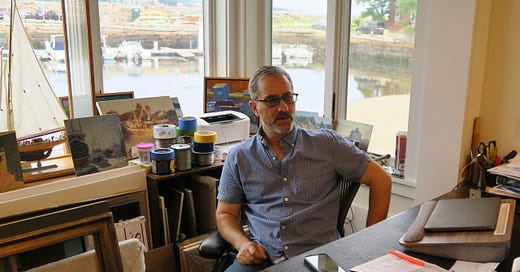



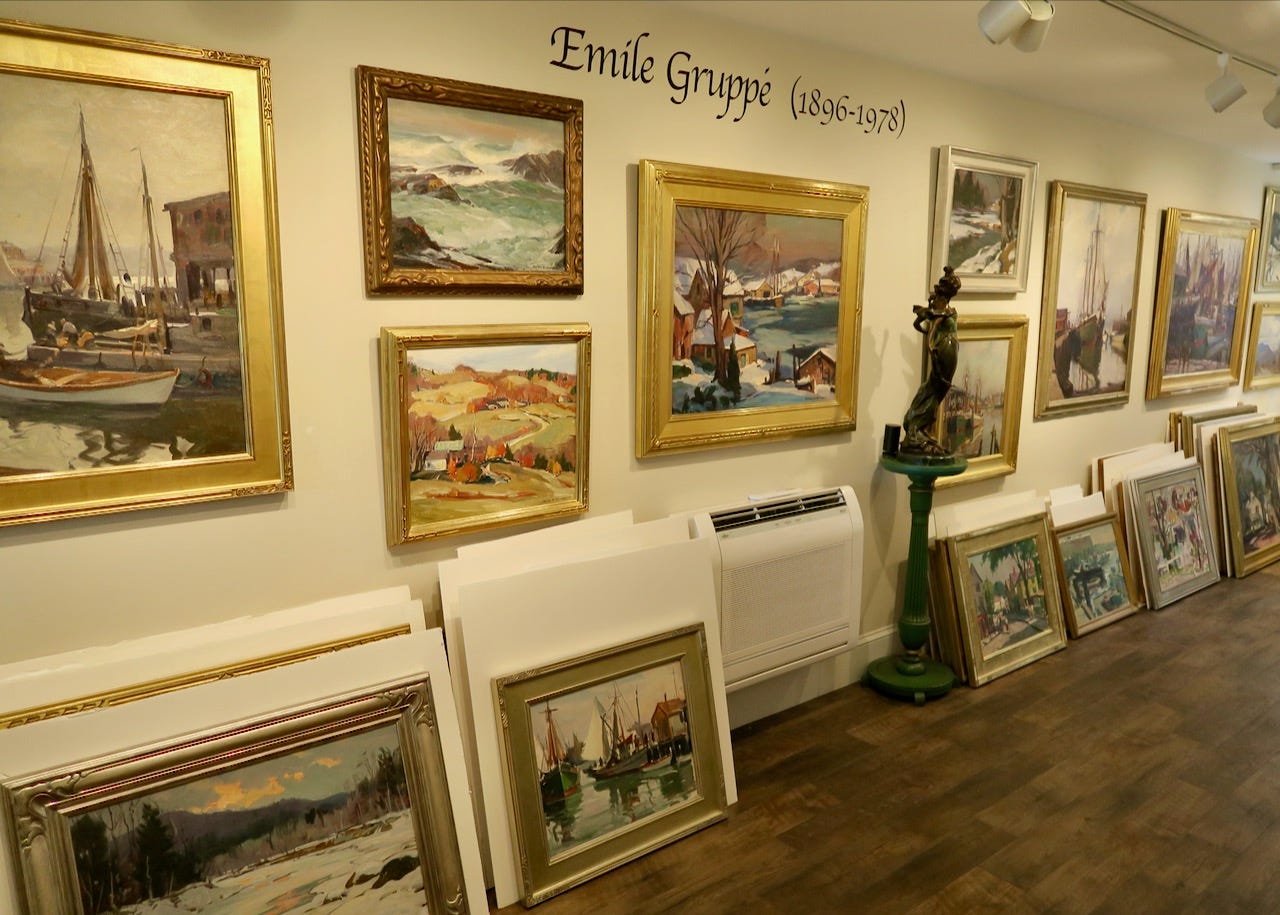
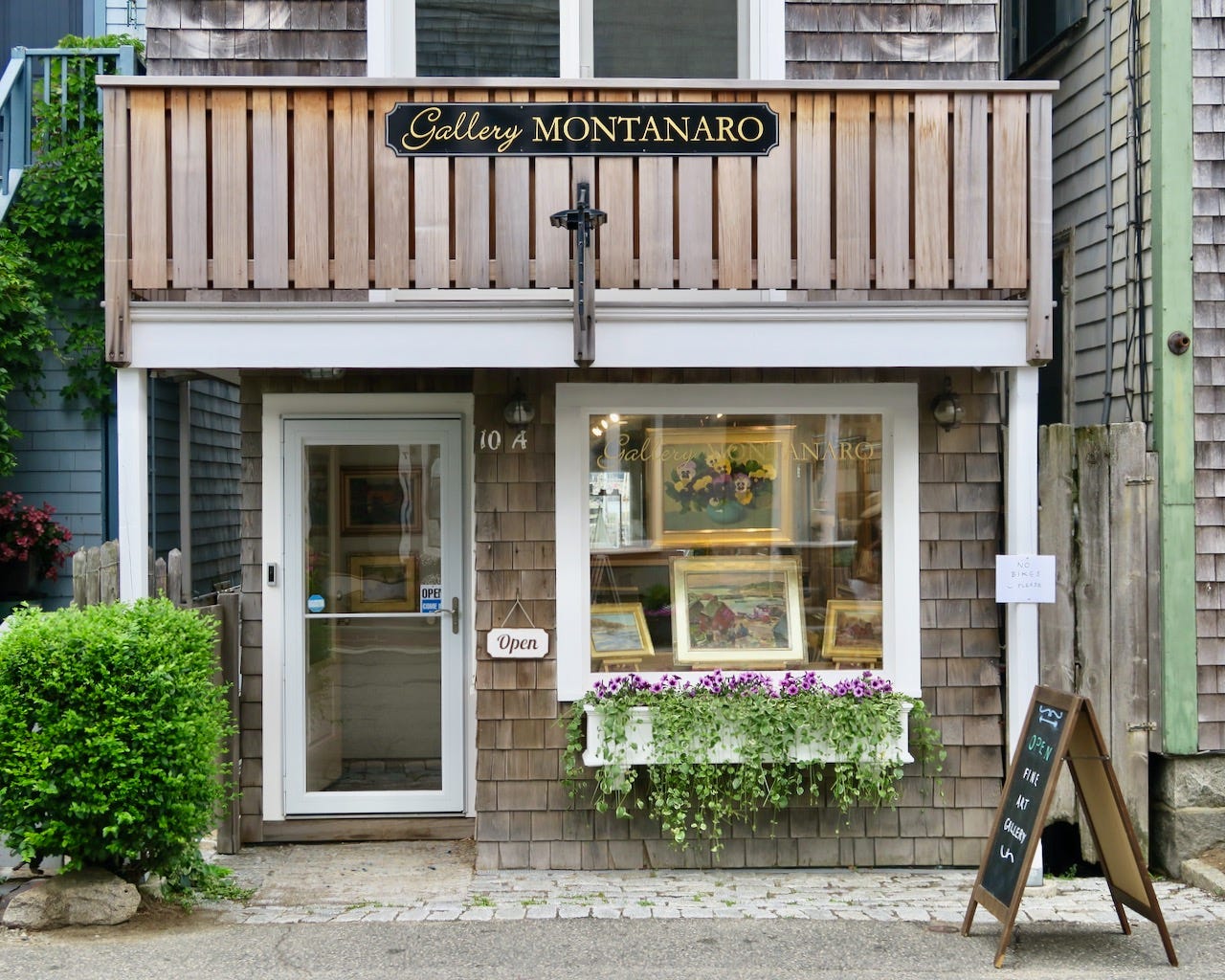
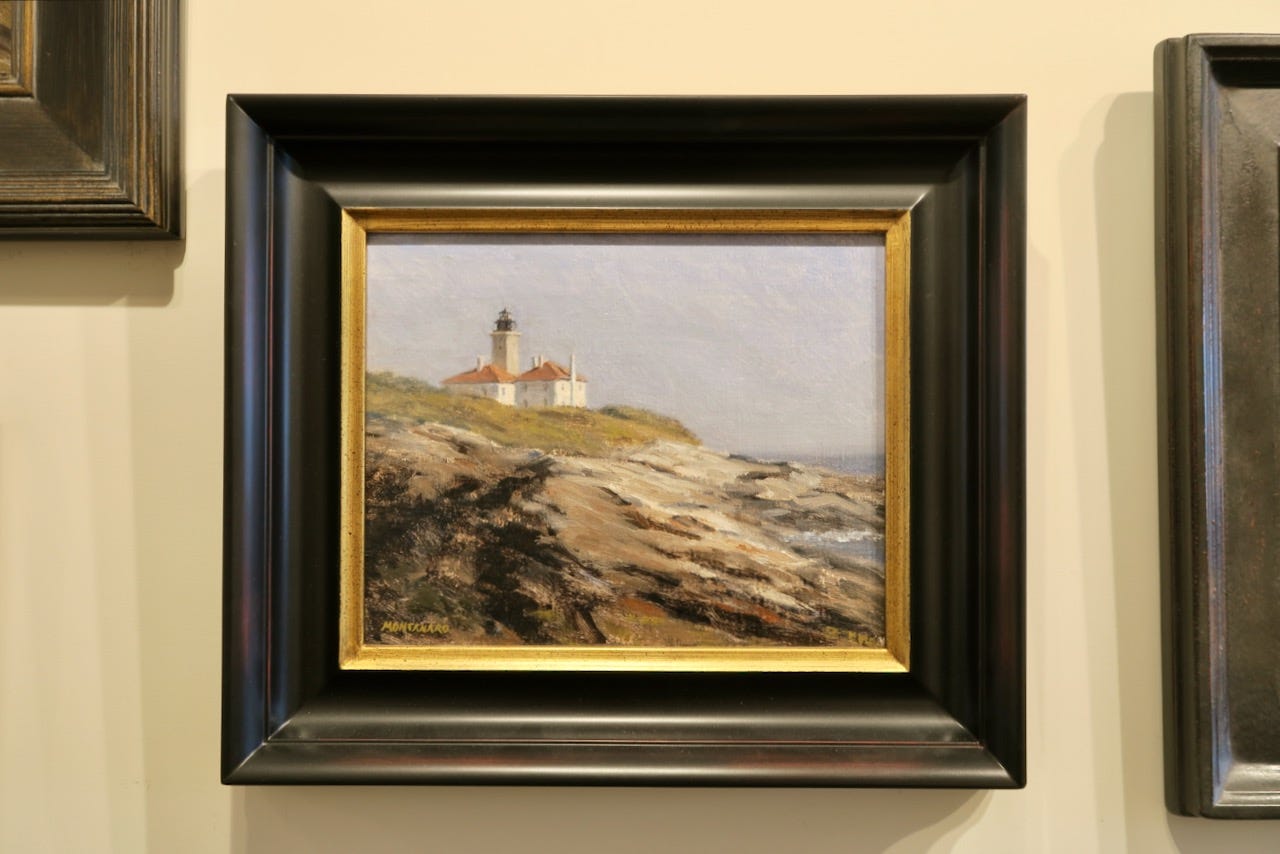
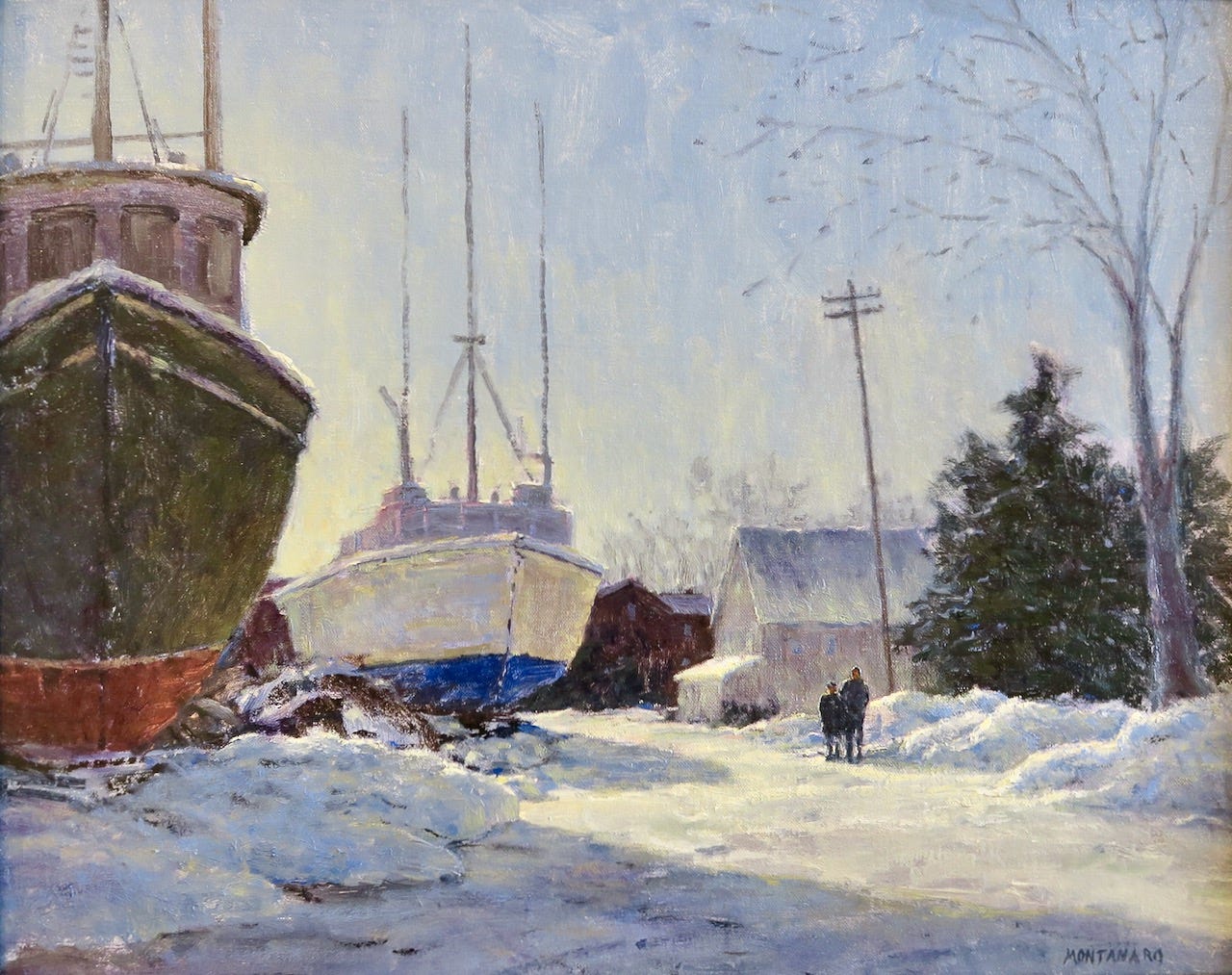
Interesting interview and great visuals!
Really enjoyed this interview with Todd Montanaro. I'm not a painter, but I do cook. It would be fun to make a from-scratch pizza with Todd Montanaro. Loved his introspection. It feels like you really enjoyed doing this interview--actually, who wouldn't! He's really diverse and that makes him a delightful person to meet.